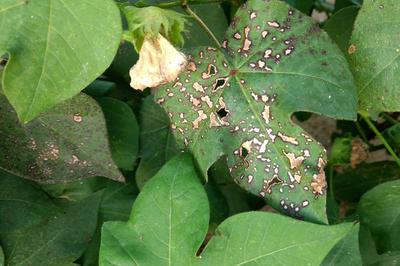Wet Weather Blight of Cotton
Ascochyta gossypii
Fungus
In a Nutshell
- Light spots on cotyledons and lower leaves of seedlings.
- Tan spots with dark margin on leaves.
- Elongated dark cankers on stems.
Can also be found in
Symptoms
Ascochyta blight typically occurs early in the season. It is characterized by circular, light brown or white spots of different sizes on cotyledons and lower leaves of seedlings. These lesions can reach a considerable size and have a purplish-brown border. Later infections show as tan spots on mature leaves, also with a dark brown margin. Lesions may coalesce, forming extensive tan blotches. The center of these lesions later turn light brown or grayish and papery, eventually falling out. Elongated, black or ash gray cankers are visible on stems, mainly after several consecutive days of cloudy, wet weather. Here too, small, black specks are likely to be visible on the lesions. Over time, the cankers may dry, crack and girdle the stem, killing the distal parts of the plant. Flowers are not attacked, but bolls may be half-opened and show lint with a grey discoloration.
Recommendations

Organic Control
As of today, no biological treatment seems to be available against this disease. Copper-based fungicides such as Bordeaux mixture can be used to decrease the spread of the disease. Note, however, that this can also cause a toxic reaction in the plants.

Chemical Control
Always consider an integrated approach with preventive measures and biological treatments if available. Seeds may be treated with a seed dressing based on thiram or thiram + thiabendazole before sowing. Preventive foliar fungicides based on chlorothalonil can be used, especially if a susceptible variety is grown. Once the disease is detected, a rotation of foliar fungicides with a systemic mode of action are recommended (boscalid, mancozeb, pyraclostrobin + fluxapyroxad). Treatments may need to be applied throughout the growing season to avoid serious yield losses.
What caused it?
Ascochyta Blight has been reported in most major cotton producing regions and is caused by the fungus Ascochyta gossypii. It can overwinter on plant residues for several years and under favorable conditions, it produces spores that are later spread by wind and rain splashes, sometimes over distance of several kilometers. Cool, cloudy and rainy weather, high humidity, morning dew and prolonged leaf wetness (2 hours or more) favor the spread of the disease, particularly during early plant stages. The fungus can develop over a wide range of temperatures (5-30°C) but optimal growth is reached between 15-25°C. Multiple cycles of infection can occur during the growing season if conditions are favorable. Yield losses are rarely reported, but are possible under favorable conditions.
Preventive Measures
- Choose more resilient varieties if available.
- Use certified disease-free seeding material.
- Alternatively, use seeds from an healthy field.
- Follow recommendations in regard to seed rates to avoid dense canopies.
- Plant later to avoid worst effect of the disease.
- Monitor fields for signs of the disease.
- Rogue diseased plants, volunteer plants and weeds in and around the field.
- Practice good farm sanitation practices, for example washing boots and clothes and cleaning tools.
- Avoid excess watering and overhead irrigation.
- Avoid field operations when the leaf surfaces are wet.
- Harvest as early as possible to avoid the worst effects on yields.
- Bury the residues deep into the soil to reduce the carryover of the fungus into the following season.
- Alternatively remove them and destroy them by burning.
- Plan a 2-3 year crop rotation with non-susceptible plants.



